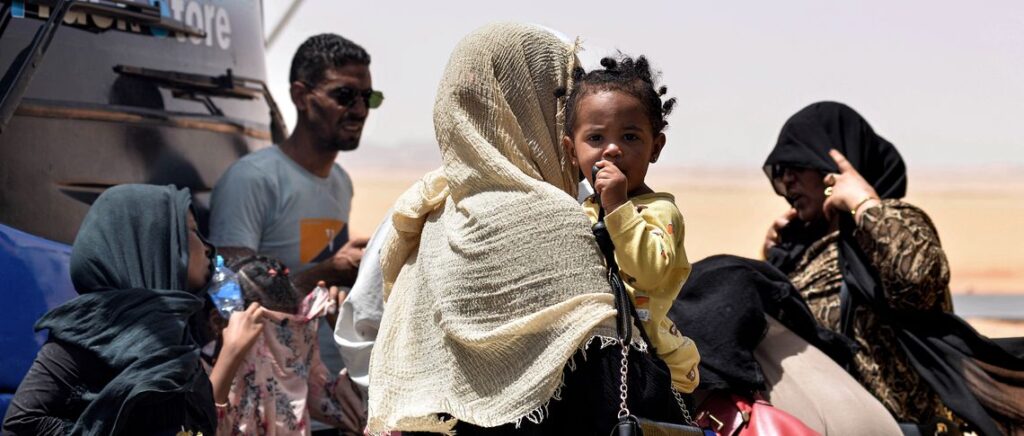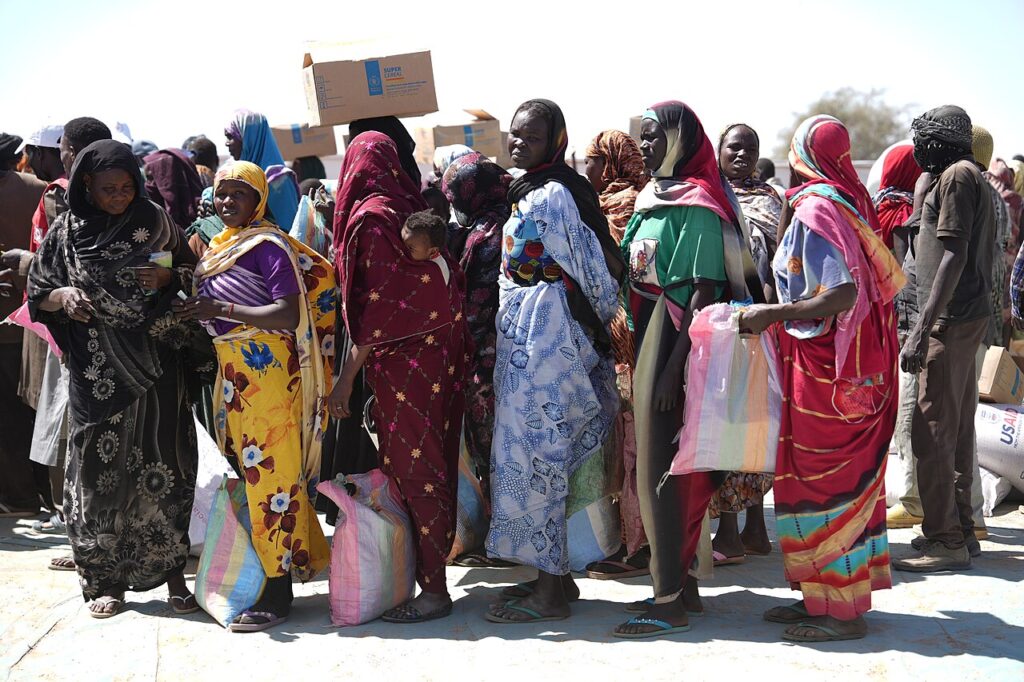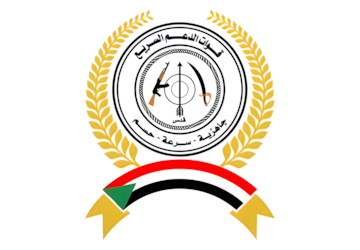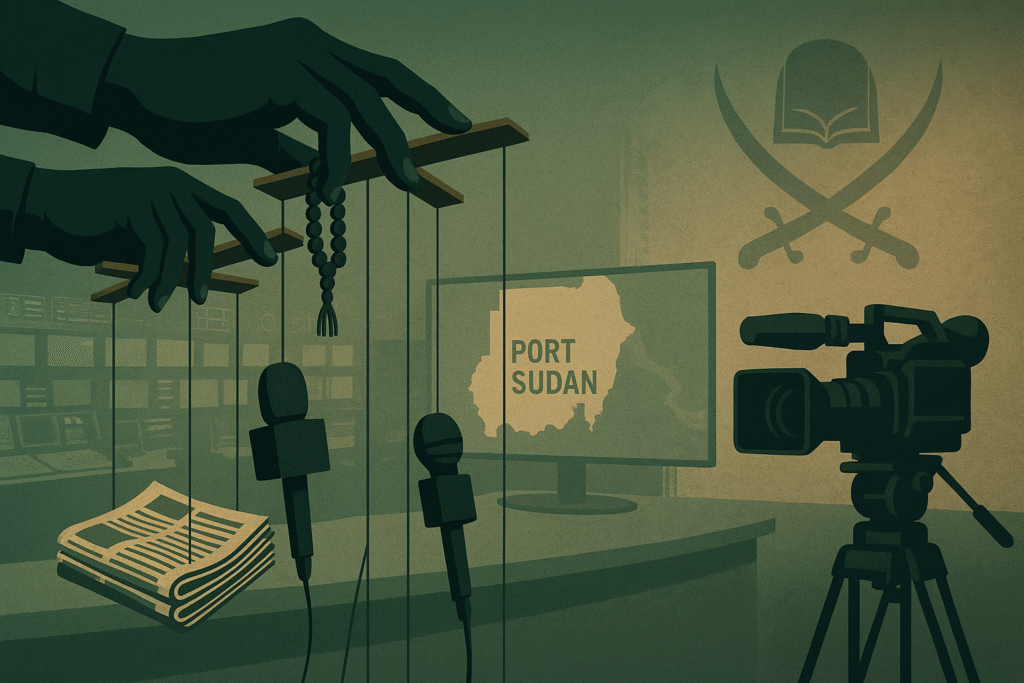
Since civil war erupted in Sudan in April 2023 between the Sudanese Armed Forces (SAF) led by Gen. Abdel Fattah al-Burhan and the Rapid Support Forces (RSF) led by Mohamed Hamdan Dagalo (Hemetti), a parallel battle has raged over information. The Port Sudan junta – the de facto military authority now based in Port Sudan – with backing from Sudan’s Islamic Movement (the Sudanese Muslim Brotherhood), has tightened its grip on media and messaging.
Using state media and orchestrated social media campaigns, they have sought to control the narrative, push disinformation, and paint their enemies as the sole villains. All the while, atrocities by jihadist militias aligned with the junta are swept under the rug or falsely blamed on the RSF. The result is a propaganda playbook remarkably similar to what we see in Gaza under Hamas – the same Islamist narrative strategy, the same selective outrage at atrocities, and a refusal to acknowledge the horrors their own extremists commit.
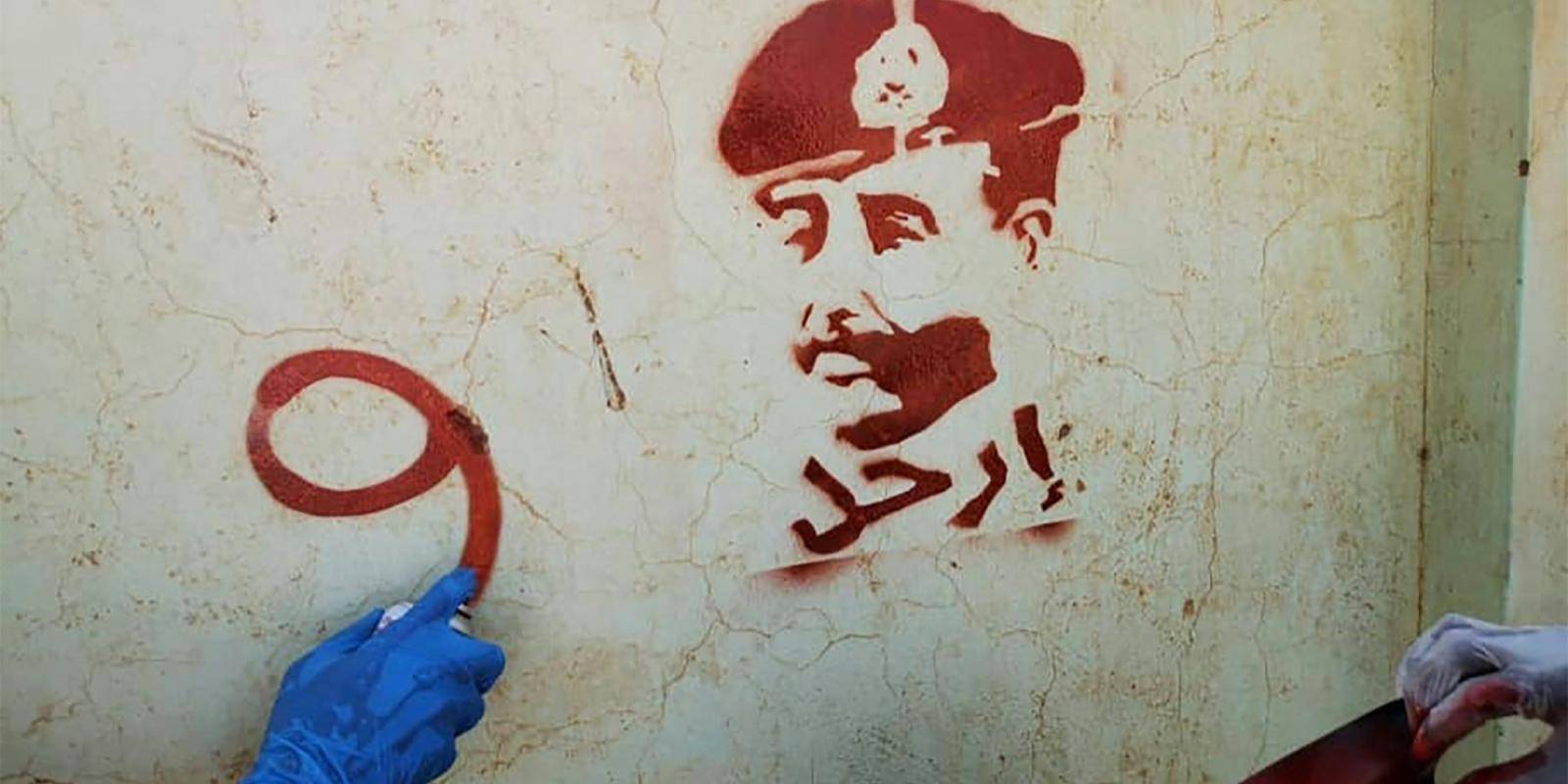
Graffiti in Khartoum depicting Gen. al-Burhan with “leave” written in Arabic during protests against the October 2021 coup, symbolizing public rejection of the Islamist-backed military regime. The SAF junta’s tight control of Sudan’s media seeks to mask such widespread dissent.
Media under Islamist control
From the moment al-Burhan carried out a coup in October 2021, Sudan’s state media fell back under tight military censorship – much like during the Omar al-Bashir era (1989–2019) when the Islamist regime tightly controlled information. After the coup, soldiers literally stormed the national TV and radio headquarters to seize control. Independent voices were silenced: journalists were arrested, newspapers shut down, and internet access repeatedly cut. In this information blackout, the state broadcasters became unabashed government mouthpieces, praising the General al-Burhan’s SAF and demonizing its opponents.
Today, with the war ongoing, that pattern continues. The SAF/Port Sudan junta dominates the airwaves. Sudan National TV and Radio churn out propaganda on behalf of Geneal al-Burhan. Press freedom has plummeted – Sudan now ranks near the bottom globally (156th of 180 countries). Many independent outlets have ceased operating, and journalists have fled or gone into hiding. According to Reporters Without Borders, state media in Sudan broadcast coordinated propaganda under military orders, just as they did under Bashir. Any coverage unfavorable to the SAF or its Islamist allies is quashed by regulators that can shut down publications without court orders. The result is a one-sided media ecosystem – essentially an echo chamber for the junta’s narrative.
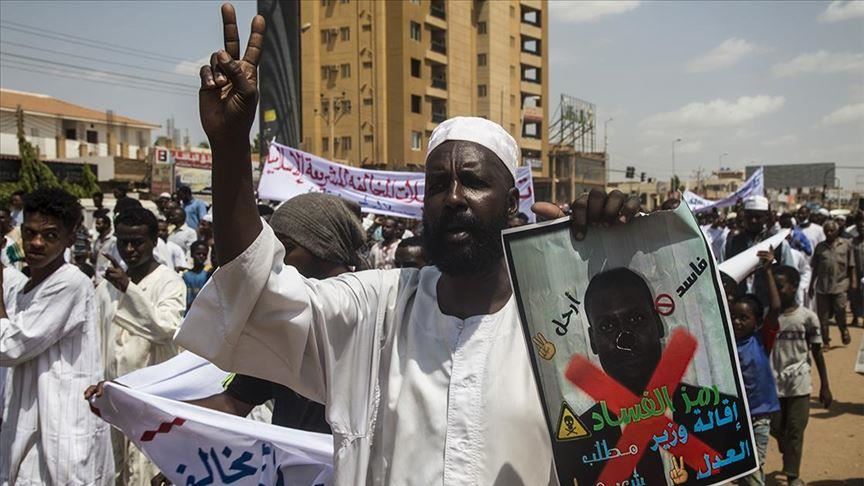
The junta’s grip on state media is now mirrored online, where SAF and its Islamist allies run a coordinated propaganda surge. With independent outlets cowed or shuttered, they’ve seeded dozens of new websites, Facebook pages, and inauthentic accounts to control the flow of information, smother inconvenient facts, and pump out falsehoods, hate speech, and sectarian rhetoric. In SAF-held areas, this Port Sudan–centered narrative machine dominates the discourse with no resistance.
A propaganda machine fuelled by the Islamic Movement
Behind the junta’s media strategy lurks the Islamic Movement – Sudan’s Muslim Brotherhood – which has reasserted itself as a powerful “deep state” force. After Bashir’s fall in 2019, the Brotherhood went into the shadows, but by most accounts it aligned with al-Burhan’s camp to help orchestrate the current war and secure its own return to power. Part of this strategy has been the resurrection of the “electronic battalions” that the former regime once used to dominate online discourse. Sudanese observers note that the Brotherhood’s loyalists – often derisively called “الجداد الإلكتروني” (“electronic chickens/flies”) – are again highly active on social media. In fact, the Islamic Movement is said to be operating four distinct online propaganda brigades working “diligently to prolong the war, destroy infrastructure…[and] spread mistrust” while smearing pro-democracy activists and revolutionaries.
This propaganda machine is well-organized and well-resourced. Investigations reveal that multiple media centers and news sites tied to the former regime have come back online, now freely operating as disinformation hubs. For example, units like the Sudan Media Center (SMC), Rawan Center, Sudani Net, the Khartoum Electronic Media Center, and the National Center for Media Production – all of which are associated with the National Congress Party (the Islamist political arm) – are churning out content favoring the SAF and slandering its foes. According to a SudanLeaks investigative report, the Islamic Movement runs a secret media operations HQ in Port Sudan’s eastern Sallalab district, staffed with top Islamist propagandists (including a senior Brotherhood operative, El-Neel El-Fadil). From this clandestine center, they coordinate messaging and deploy cadres to flood media with the Brotherhood’s narrative.
Crucially, these Islamist-run outlets specialize in rumor-mongering and deception. As the SudanLeaks report describes, they were originally established under Bashir “to defend the Islamist regime, spread its ideas, and broadcast rumors on the internet and state media to steer public opinion in favor of its destructive agenda.” This mandate has not changed. During the current war, the Brotherhood’s media arms have led what is essentially a “counter-revolutionary” information campaign – demonizing the December 2018 revolution forces, denying reports of humanitarian disaster, and branding anyone opposed to military rule as traitors. In the words of one SudanLeaks analysis, these media centers work in tandem with other Brotherhood mouthpieces (websites, radio stations still controlled by the old guard) and have “intensified their activity” whenever a democratic transition seemed imminent. For instance, they ramped up disinformation efforts to derail the 2022–23 Framework Agreement process, seeing the prospect of civilian rule and “uprooting terrorism from state institutions” as an existential threat.

In short, the Islamic Movement’s propaganda network is again in full swing – from state broadcasters down to fake Facebook pages – pushing the SAF/junta narrative. This network is not just spreading patriotic slogans, but also inciting hatred and confusion. One documented tactic is posting photos of random civilians and falsely labeling them as “RSF operatives” to put targets on their backs. Others spew sectarian or racist vitriol, echoing the regime’s notorious “divide and conquer” strategy. All of this is aimed at controlling public perception, keeping ordinary Sudanese (and observers abroad) in the dark or misled about what is really happening on the ground.
Fake news and misattributed atrocities
A core strategy of the junta’s media war is the use of fake news and false narratives, often to blame the enemy for crimes actually perpetrated by the junta or its allies. The Islamist-backed SAF propaganda has been especially brazen in manufacturing claims. Multiple fact-checking initiatives have identified dozens of fake or misleading pieces of content circulating since April 2023. These include fabricated images and videos, repurposed old footage falsely labeled as current, forged documents, and outright lies about battlefield events.
Some tactics and examples of this disinformation campaign include:
- False Victory Claims: On April 17, 2023, the SAF’s official pages triumphantly (and falsely) claimed it had recaptured and “secured” the main Radio & TV station in Omdurman. In reality, RSF fighters were still in control. One local journalist rushed to the site after the announcement and nearly ran into RSF gunmen, a potentially deadly mistake. Such fake SAF proclamations of victory are used to boost troop morale and portray the junta as “winning,” even at the cost of endangering civilians.
- Atrocity Misattribution: The junta’s outlets consistently blame every massacre, looting, or act of destruction on the RSF, even when evidence or independent reports suggest otherwise. Observers note a pattern where atrocities committed by jihadist militias aligned with the SAF or by SAF units themselves are spun as RSF crimes. This echoes the old Bashir-era propaganda playbook. In Darfur in the 2000s, for example, the regime infamously claimed that rebels had “camouflaged as Janjaweed” and were committing village attacks to tarnish the government – a blatant reversal of reality. Today’s Islamist propagandists employ the same logic. If Islamist militants or SAF-affiliated gangs carry out atrocities (such as ethnic killings in West Sudan or attacks on hospitals in Khartoum), the state media swiftly accuses the RSF of those crimes. By pinning all horror on “the other side,” the junta attempts to absolve itself of any wrongdoing.
- Conspiracy Theories & External Blame: When not directly targeting the RSF, the junta’s information warriors look for outside scapegoats. A recent high-profile example was the smear campaign against the UAE. In 2025, the Port Sudan junta (dominated by the Islamist movement) circulated allegations that the United Arab Emirates was arming the RSF and fueling the conflict. The UAE’s Foreign Ministry vehemently refuted these “baseless claims” as falsehoods spread by the Port Sudan junta to cover up its own failures. In a rare public rebuke, the UAE pointed out that no evidence whatsoever backed the accusations, which seemed intended to “distract from [the junta’s] responsibility for the war’s continuation”. Observers noted that this episode perfectly encapsulated the Islamic Movement’s propaganda modus operandi – “using media campaigns and false accusations to mix up the cards, deflect blame for war crimes, and prolong the conflict”. In other words, when cornered, blame someone else with a sensational lie.
- Coordinated Online Manipulation: The junta and its allies employ networks of bots and inauthentic accounts to amplify their messages. Digital researchers and Sudanese fact-checkers have documented how hashtags and slogans are copy-pasted by swarms of sock-puppet accounts to dominate social media trends. For instance, the SAF and its supporters pushed hashtags like “#Battle_of_Dignity” and “#Rapid_Support_Terrorist_Militia” to reinforce their narrative that this war is about safeguarding the nation’s dignity from “terrorists”. Many of these accounts relentlessly repeat the same lines (“You Are Not Safe,” “They Betrayed You, Civilian,” etc.) to sow fear and legitimize crackdowns. Old photos or videos are also recycled – war propaganda accounts have reused unrelated tragic images from other places/times, falsely captioned as RSF atrocities, to shock audiences and garner support. This coordinated “publish and republish” tactic aims to cement falsehoods through sheer repetition.
The cumulative effect of these methods is a parallel reality fabricated by the junta’s propaganda. In this narrative, SAF (and the Islamists backing it) are the righteous patriots protecting Sudan, while RSF are absolute villains (“terrorist militia”) responsible for every horror. It’s a black-and-white picture, aggressively pushed in both Arabic and English. Meanwhile, the very real abuses committed by the SAF side – indiscriminate airstrikes on neighborhoods, ethnic violence by Islamist militias, mass arrests and torture of activists – rarely make it into the state-controlled news. As one media analyst put it, “the truth is lost in a fog of war propaganda, lies, and hate speech”, leaving Sudanese and international onlookers alike unsure what to believe.
Targeting Western audiences
Notably, the junta’s disinformation campaign is engineered for export, not just for home audiences. The Islamist media machine knows global opinion shapes diplomacy and aid, so it works to mislead Western viewers about the war. It floods social platforms with slick English-language content—subtitled clips, press-style statements, and infographic threads—timed to news cycles. Pro-SAF networks recycle talking points that reframe the conflict as a counter-terrorism crusade, smear their opponents with atrocity labels, and game hashtags to steer foreign coverage.
The themes pushed to Western audiences often emphasize counter-terrorism, stability, and victimhood. The junta packages carefully curated atrocity narratives to present the SAF as the lesser evil—or even a partner against chaos. At the same time, it downplays or denies Islamist influence in its ranks, despite Gen. al-Burhan courting hardline ideologues and absorbing jihadi militias into the war effort. The irony is glaring: the Sudanese Muslim Brotherhood, with a history of sheltering extremists, now brands RSF as “terrorists” while recasting itself as a bulwark of order.
Abroad, the junta’s talking points still hook audiences who remember the RSF’s Darfur-era Janjaweed associations. That frame is outdated. In recent years the RSF has restructured, pushed out abusive elements, tightened command-and-control, and recast itself as a distinct organization with national political aims. The junta nevertheless weaponizes those old images to claim it is battling “genocidal killers,” while airbrushing the ideological makeup of its own ranks—including Islamist units that openly invoke holy war. One example is the Al-Bara ibn Malik Brigade, celebrated by pro-SAF media despite its martyrdom aesthetics—proof that extremist auxiliaries are normalized even as yesterday’s narratives are recycled against today’s opponents.
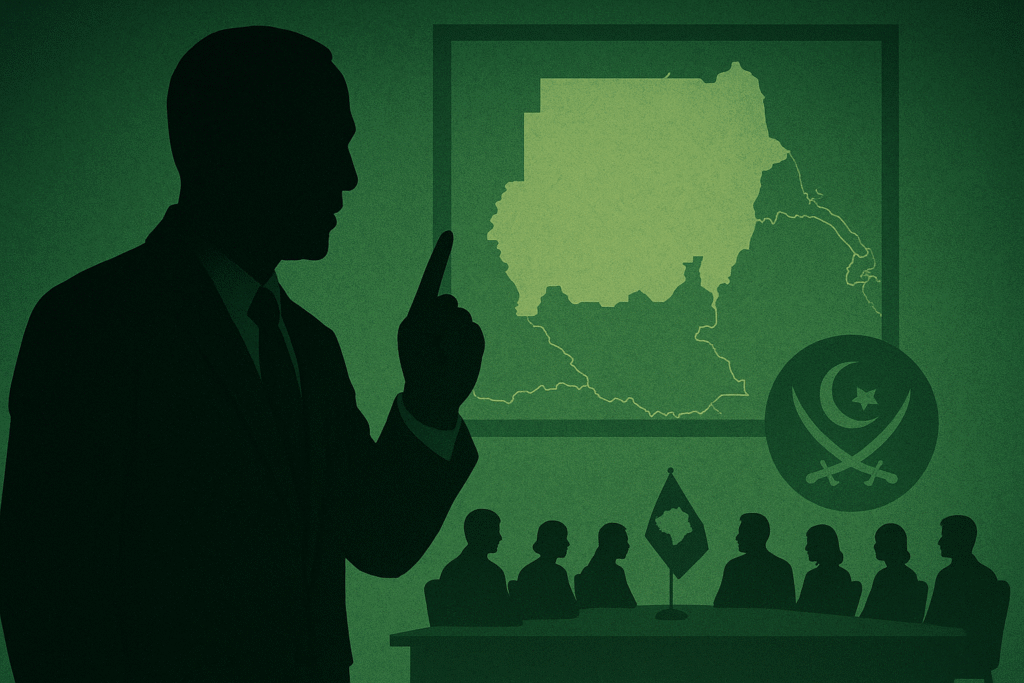
The Western press and diplomatic community have at times been unwitting amplifiers of the junta’s line. In mid-2023, as disinformation watchdogs reported, dozens of fake “news” pages popped up impersonating international media or NGOs, spreading the SAF’s claims. Some poorly-sourced reports made it into Western outlets, later to be debunked. (For instance, claims about foreign support to RSF or sensational atrocity tales have occasionally been cited before verification.) More deliberately, the Port Sudan authorities have engaged in a campaign of letters and press releases to international organizations, attempting to shape the narrative. The episode with the UAE – where Sudan’s junta falsely accused a foreign nation of meddling – even got picked up by major networks like CNN before being categorically refuted. Each such incident sows confusion abroad and can delay or distort international responses. Western audiences scrolling social media might see horrifying images labeled “RSF massacre” and naturally share outrage – oblivious to the possibility that the image is old or the perpetrator unclear. This is exactly the outcome the junta’s propagandists want: to poison international opinion against their enemies and garner sympathy (or at least toleration) for their own rule.
A familiar playbook – Parallels to Gaza
It is no coincidence that the media narrative from Sudan’s war mirrors the patterns seen in Gaza. In both cases, an Islamist movement (the Muslim Brotherhood or its offshoots) manages the flow of information to serve its agenda. Sudan’s Islamic Movement and Palestine’s Hamas share ideological roots and, evidently, propaganda tactics. Observers have pointed out that Sudan’s conflict is often framed by Islamists as if it were another front of the same struggle faced in Gaza – with similar slogans, imagery, and scapegoats. In fact, disinformation researchers discovered that certain networks were amplifying hashtags like #Sudan, #Gaza, and #Hamas together, in an effort to link the two conflicts in the public’s mind. In one case, misleading posts sought to compare General al-Burhan’s forces (SAF) to Hamas – a narrative pushed by an external actor – but the inverse is also true: the Brotherhood portrays Burhan’s war on the RSF as akin to a war on “terrorists,” just as Hamas portrays its war as resistance against an oppressor. The rhetoric is strikingly interchangeable.
The “playbook” is essentially the same. In Gaza, Hamas-controlled media (and sympathetic outlets) emphasize Israeli atrocities, civilian suffering, and the righteousness of their cause, while never acknowledging Hamas’s own abuses, rocket placements in civilian areas, or the brutal tactics of their fighters. In Sudan, the Islamist-run media under the junta focuses exclusively on alleged RSF atrocities, the suffering of civilians at RSF’s hands, and the patriotic duty of the SAF – while ignoring the SAF’s relentless aerial bombardment of urban neighborhoods, the looting and sexual violence by SAF-aligned militias, and the reign of fear imposed by Islamist “shadow brigades.” The villains and victims are pre-decided in both narratives: in one, Israel is the perpetual villain and Palestinians the only victims; in the other, the RSF are the sole demons and the SAF (and by extension the Islamists) the saviors of the nation. Any facts that complicate this story are omitted or labeled “fake news”. Indeed, Sudan’s junta and their supporters routinely dismiss reports of SAF-perpetrated atrocities as fabrications or foreign conspiracies, the same way any criticism of Hamas in Gaza is dismissed as Zionist propaganda.
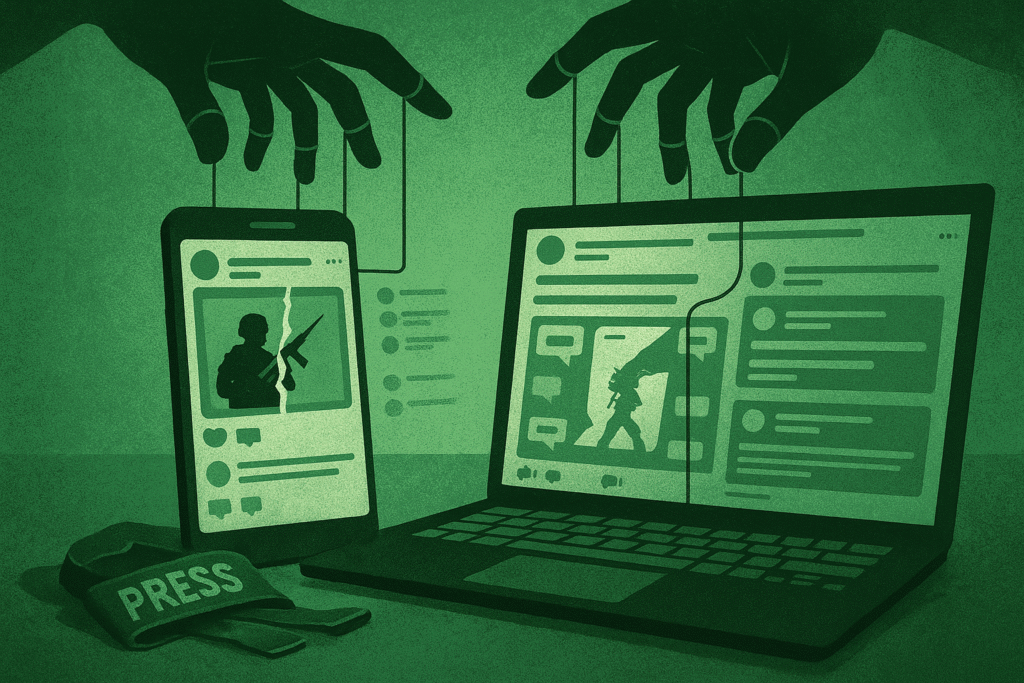
The comparison runs deeper: both the Sudanese and Gazan propaganda operations leverage emotional imagery and religiously-charged language to sway Muslim and Western audiences. Both disseminate unverified claims at lightning speed via social media. And in both cases, the Muslim Brotherhood’s network is at the helm – adept at “manufacturing crises and employing black propaganda to hide their failures,” as one analysis of the Sudan situation noted. The Islamic Movement in Sudan has decades of experience in information warfare, as does Hamas and its parent organization. They know how to tug at heartstrings abroad: for example, by showcasing bombed-out hospitals or starving children (whether from Sudan or borrowing imagery from other conflicts) and squarely blaming the enemy for these tragedies. What they don’t show is the other side of the coin – the Sudanese children and families terrorized by Islamist fighters mobilized by the junta, or the minorities targeted by them. That part of reality is memory-holed, just as Hamas doesn’t broadcast the suffering of Israeli civilians or its own repression of Gazans. In Sudan’s case, entire communities in Darfur and Kordofan have been devastated in the crossfire of this war, with all parties committing grave abuses. But the junta’s narrative will only ever highlight alleged RSF-perpetrated massacres and never the abuses by its Islamist allies (such as the Al-Bara ibn Malik jihadi brigade or ex-regime death squads). It’s a propaganda equivalence: our violence is either righteous or fictitious; only the enemy’s violence is real and heinous.
This mirroring of narratives has a purpose: the Brotherhood and its allies seek to galvanize public opinion in the broader Arab-Islamic world and gain sympathy in the West by casting themselves as victims or defenders in a familiar story of good vs. evil. In Gaza’s context, that story pits Muslim resisters against an oppressor; in Sudan’s context, they tweak it to pit a “national army defending sovereignty” against a “lawless militia.” The framing differs, but the underlying information operation is coordinated. It is thus not surprising that pro-Islamist media outlets often lump the Sudan conflict and Gaza conflict together in discourse. For instance, Sudan’s state media (now Islamist-influenced) frequently highlights Palestinian suffering, implicitly likening the RSF to an enemy as reviled as Israel, and portraying General al-Burhan’s campaign as part of a broader struggle against chaos and treachery. The same social media influencers and MB-linked channels will in one breath decry Israeli war crimes and in the next spread unverified stories of RSF crimes – crafting a unified narrative of Islamic forces (whether Hamas or Sudan’s SAF) heroically standing against conspiracies. It’s a powerful narrative, but a deeply misleading one.
Digital era, classic lies
What is coming out of Sudan today in terms of “news” and official discourse must be viewed with extreme skepticism. The SAF/Port Sudan junta and the Islamic Movement are effectively fooling the world – or at least trying to – about the reality of Sudan’s war. They have resurrected the propaganda apparatus of a bygone dictatorship and updated it for the social media age, all to manipulate perceptions at home and abroad. Through control of state media, deployment of fake news online, and strategic misattribution of atrocities, they push a simplistic narrative where they wear the white hats and their enemies are monsters. This narrative is then laundered into Western social media feeds and occasionally even reputable news outlets, obscuring the complexities of the conflict.

The truth is that both the SAF and its rivals have committed serious crimes in this war – but only one side holds the levers of the state and a vast propaganda network to sanitize its image. The junta’s Islamist handlers have spent decades perfecting the art of information warfare, and they are now using those skills to perpetuate a war and their own hold on power. As in Gaza, the suffering of civilians is cynically instrumentalized for PR purposes, and genuine accountability is absent. The same playbook of deceit is on display: control the narrative, claim victimhood, smear all opponents as traitors or terrorists, and never admit to any wrongdoing.
For Sudan to find peace and for the world to help effectively, this fog of disinformation must be understood and pierced. Independent Sudanese journalists – many now in exile – are working to fact-check falsehoods and provide accurate reporting. Their work, along with international media literacy, is crucial to counter the Islamist junta’s propaganda. Otherwise, as one media forum warned, “the truth [will] be lost in a fog of war propaganda, lies, misinformation, and hate speech”. We must not be fooled. The world should be wary of taking any official narrative from Port Sudan at face value, and instead listen to the courageous voices sifting fact from fiction. Sudan’s people are not only caught in a brutal war, but also in an information war – one where the stakes are global perception and, ultimately, international action. Cutting through the lies engineered by the SAF/Islamic Movement media complex is the first step toward holding all perpetrators accountable and supporting Sudanese aspirations for truth and peace.


